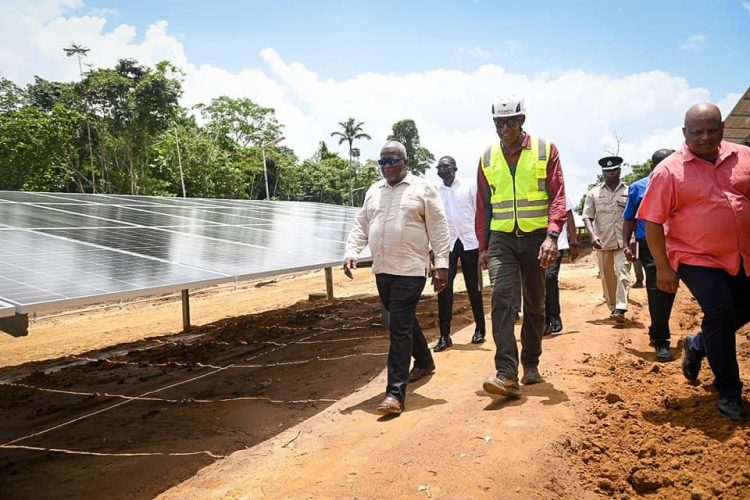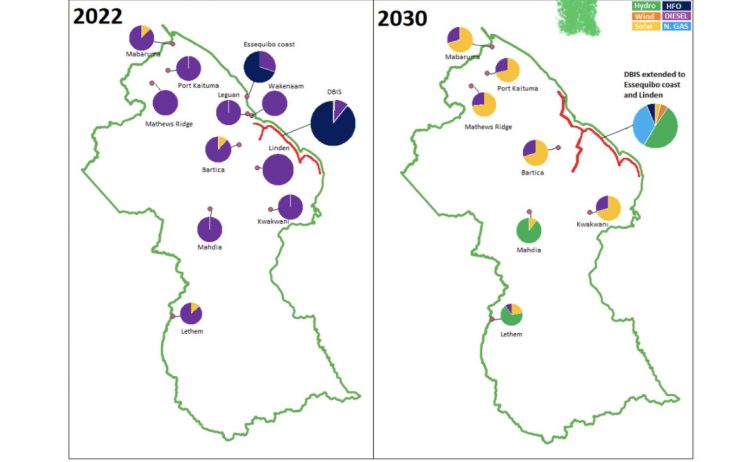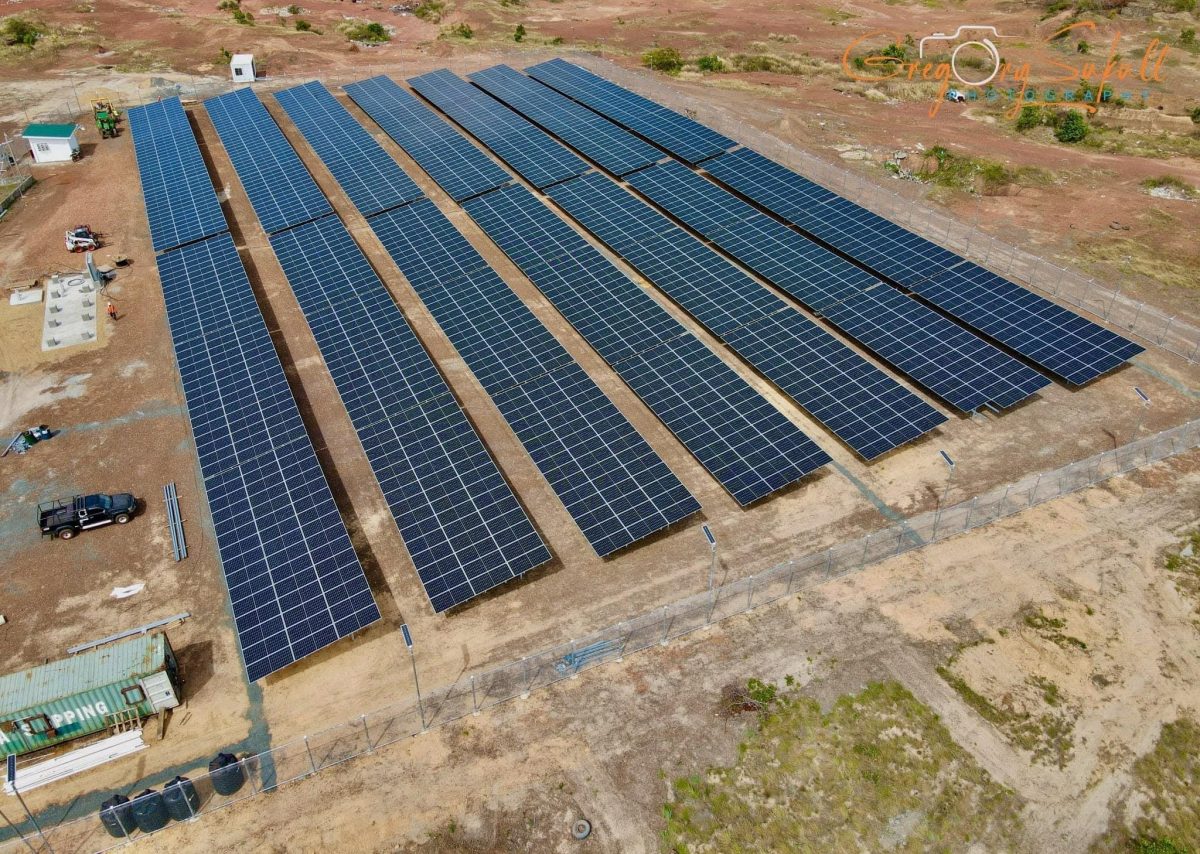Solar power generation via photovoltaic (PV) farms is leading the way in the government’s multi-pronged efforts to reduce greenhouse emissions and transition Guyana to sustainable sources of alternative energy.
Guyana’s latest installation of solar power grids across the country has resulted in the reduction of some 3,542 tonnes of carbon dioxide per year, Head of Guyana Energy Agency Dr Mahendra Sharma says.
Since the renewable power integration roll out, Sharma explained, more than 8 Megawatts (MW) of grid-connected and off-grid solar installations have been completed at 442 locations across the country.


Government’s programmes between 2021 and 2022, he said, saw the completion and installation of solar farms at Lethem and Bartica, 28 solar mini-grids, and 29 off-grid locations, totaling 3.415MW of installed capacity benefiting some 52,940 persons. To date, these programmes resulted in an estimated 9,000 tonnes of carbon emissions being reduced from the country’s electricity generation and usage.
According to Sharma, “The integration of renewable energy has resulted in the reduction in the use of fossil fuel and the avoidance of carbon dioxide emissions.”
In this regard, he pointed out that from the recent installation of the 1MW Lethem Solar Grid, the country has been able to to generate 279.7 megawatt-hours of electricity since its commissioning in August 2022, resulting in savings of “72,711 litres of diesel or about 457 drums of diesel and avoiding the emission of 223,728kg carbon dioxide as at Oct 9, 2022.”
“The renewable energy projects have been able to demonstrate the practical application of renewable energy technology in the local context and raise public awareness,” Sharma underscored.
Over the last ten years, successive governments have been engaged in an accelerated energy transition programme in the country to meet international climate commitments and increase energy capacity to meet demands by citizens. In addition, government’s accelerated roll out of alternative energy generation also provides the foundation for an expanded network for electricity generation and cheaper electricity. Currently, citizens pay approximately 32US cents hourly per kilowatt, a sum that is way too high, Vice President Bharrat Jagdeo has said. It is the PPP/C’s government aim to reduce the cost of electricity by 50% of the current cost.
With more solar farms expected to come on stream and to be fed into the national grid in the near future, two major townships Lethem, Region Nine and Mabaruma, Region One, are already being powered by solar farms in a hybrid power generation model. By November of this year, a third township, Bartica, in Region Seven, will also have additional power generating capacity when its 1.5 MW solar farm comes on stream.
Adding to this infrastructure, the office of the Prime Minister signed a contract for the construction of a turnkey 686 kWp solar farm in Mahdia with a local company, Standby Power Engineering Company (SPECOM). The farm will be constructed in Region Eight at a cost of $362.4 million.
Just a month ago, the government announced that it has sealed a deal with the Inter-American Development Bank (IDB) for 33 megawatts (MW) of solar power farms. This deal is being financed by US$83.3 million in funds from Norway, derived from the ground-breaking forest protection accord signed between Georgetown and Oslo in 2009.
The construction of the six new solar farms in Linden, Berbice and Essequibo Coast will pave the way for an additional annual savings of US$9.11 million in fuel consumption.
The three photovoltaic solar farms slated to be constructed in Berbice will be constructed to feed into the Demerara\Berbice Interconnected system. The three farms are expected to generate approximately 16.78GWh annually, which will be fed into the national grid, an announcement of the deal from the Ministry of Finance pointed out.
Consistent power
In Mabaruma, where the first PV solar farm was installed, the off-grid community has seen an increase in power supply from the 4.0 megawatts farm.
Susan Boyer, a resident of the community, explained the hybrid solar farm, which provides approximately 15 hours of electricity per day, has been a great benefit to the commercial district.
“The business community has really been able to benefit from it. It doesn’t work well all the time, but we are able to save on fuel and operate a business,” she said. She noted that in the past both residents and business operators were forced to utilise gas and diesel power generators. However, since the solar farm began to feed into their local power grid they have been benefiting from consistent power. But they, like many other Guyanese do not escape power outages at intervals. She explained power outages occur when the grid is over burdened by demand.
Apart from the township, satellite villages also now receive electricity from the solar farm.
But while the government is pursuing an accelerated implementation plan, its progress is snagged by challenges beyond its control. Sharma said apart from the project being capital intensive due to the high cost of batteries, they also face delays in the manufacturing and delivery of imported goods
With the country’s current growth trajectory, it is projected, electricity demands will be five times the current demands by 2030. The transition efforts now to alternative energy sources will lay the foundation for the country to meet demands in the future and still maintain a relatively flat greenhouse emission, the government’s revised Low Carbon Development Strategy (LCDS) states.
“In the period 2022 to 2028, a near tripling of electricity demand will be met mainly through a combination of natural gas… coupled with a major expansion of solar power for the main coastal urban areas and with batteries for off-grid areas,” it adds.
Moreover, with incentives implemented by the government, several private sector businesses will have taken advantage and moved to fully rely on solar energy. In addition to private sector businesses, the operations of Caribbean Community (CARICOM) Secretariat are also fully powered by a PV system.
Under the incentive programme, the government has granted zero-rated and made items such as solar panels, solar lamps, wind turbines, deep cycle batteries, among other things, fully exempt from import duties.
The GEA head explained that currently there are 54 entities which have opted to generate their own energy. This represents a total of1.4MW of installed capacity.
Feed in
“The Government welcomes the participation of private businesses in the clean energy transition and sees the private sector as a key partner in financing and developing projects to advance emerging renewable energy and energy efficiency technology,” Sharma stated.
He added that Guyana Power and Light (GPL), which is already embracing renewable energy opportunities, is currently developing a feed-in mechanism to encourage more solar PV grid-connected systems.
“The energy from the sun follows the business cycle thereby making solar a good complement for businesses and a viable opportunity to reduce energy costs and aid in our decarbonization efforts in the energy sector,” he posited.
In September, the IDB made a request for Expressions of Interest (EoI) for a consultancy to determine the renewable energy hosting capacity limits in the GPL distribution system as well as to develop a distribution code for Guyana.
The consulting firm is intended “to support the GPL in their grid modernisation (smart grid deployment) which will accommodate intermittent renewable energy systems into the grid. This consultancy is estimated for a period of 6 months to be completed by the end of April 2023,” the IDB said.
Other alternatives
Additionally, while great effort is being placed on solar farms, the government is currently pursuing other energy options such as mini hydro-power dams and a gas to shore energy plant along with alternatives.
Sharma related that the construction of the two hydropower plants at Kumu (1.5 megawatts) and Moco Moco (0.7 megawatts) is in the evaluation stage and is currently under review due to the high bid prices received following a re-tender of the project.
The gas to energy project is slated to come on stream by 2024 and the government is currently in the procurement stage of the project.






